Deck 13: Chemical Kinetics: Reactions in the Atmosphere
Question
Question
Question
Question
Question
Question
Question
Question
Question
Question
Question
Question
Question
Question
Question
Question
Question
Question
Question
Question
Question
Question
Question
Question
Question
Question
Question
Question
Question
Question
Question
Question
Question
Question
Question
Question
Question
Question
Question
Question
Question
Question
Question
Question
Question
Question
Question
Question
Question
Question
Question
Question
Question
Question
Question
Question
Question
Question
Question
Question
Question
Question
Question
Question
Question
Question
Question
Question
Question
Question
Question
Question
Question
Question
Question
Question
Question
Question
Question
Question

Unlock Deck
Sign up to unlock the cards in this deck!
Unlock Deck
Unlock Deck
1/155
Play
Full screen (f)
Deck 13: Chemical Kinetics: Reactions in the Atmosphere
1
The order in which ozone, nitrogen monoxide, and nitrogen dioxide build up in the atmosphere over the course of the day is ________, then ________, then ________.
A)NO; NO2; O3
B)NO; O3; NO2
C)NO2; NO; O3
D)NO2; O3; NO
E)O3; NO; NO2
A)NO; NO2; O3
B)NO; O3; NO2
C)NO2; NO; O3
D)NO2; O3; NO
E)O3; NO; NO2
NO; NO2; O3
2
Indicate which of the following compounds is not a component of photochemical smog.
A)O3
B)H2O
C)NO2
D)NO
E)organic molecules
A)O3
B)H2O
C)NO2
D)NO
E)organic molecules
H2O
3
Indicate which of the following compounds is a component of photochemical smog.
A)H2O
B)CO2
C)N2O
D)O3
E)CO
A)H2O
B)CO2
C)N2O
D)O3
E)CO
O3
4
Which of the following is not important as a contributing factor to photochemical smog?
A)stagnant air
B)sunlight
C)lots of traffic
D)irrigation
E)cars without catalytic converters
A)stagnant air
B)sunlight
C)lots of traffic
D)irrigation
E)cars without catalytic converters

Unlock Deck
Unlock for access to all 155 flashcards in this deck.
Unlock Deck
k this deck
5
For the reaction 2A + 3B →4C +5D, the rate of the reaction in terms of D would be written as ________
A)( )
)
B)( )
)
C)( )
)
D)( )
)
E)( )
)
A)(
 )
)B)(
 )
)C)(
 )
)D)(
 )
)E)(
 )
)
Unlock Deck
Unlock for access to all 155 flashcards in this deck.
Unlock Deck
k this deck
6
NO2 contributes to the "brown haze" associated with photochemical smog events. At what time of day is NO2 concentration highest?
A)in the morning before rush hour
B)in the morning just after rush hour
C)midmorning
D)noon
E)midafternoon
A)in the morning before rush hour
B)in the morning just after rush hour
C)midmorning
D)noon
E)midafternoon

Unlock Deck
Unlock for access to all 155 flashcards in this deck.
Unlock Deck
k this deck
7
For the reaction 2A  4B + 3D, the rate of the reaction in terms of B would be written as ________
4B + 3D, the rate of the reaction in terms of B would be written as ________
A)( )
)
B)( )
)
C)(-
 )
)
D)(+
 )
)
E)( )
)
 4B + 3D, the rate of the reaction in terms of B would be written as ________
4B + 3D, the rate of the reaction in terms of B would be written as ________A)(
 )
)B)(
 )
)C)(-

 )
)D)(+

 )
)E)(
 )
)
Unlock Deck
Unlock for access to all 155 flashcards in this deck.
Unlock Deck
k this deck
8
One reaction that occurs in an automobile catalytic converter is the conversion of carbon monoxide to carbon dioxide. How is the rate of this reaction related to the rate at which the concentration of a reactant or product changes?
2CO(g) + O2(g) →2CO2(g)
I. Rate =
II. Rate =
III. Rate =
IV. Rate =
A)I only
B)II only
C)III only
D)II and III only
E)II, III, and IV only
2CO(g) + O2(g) →2CO2(g)
I. Rate =

II. Rate =

III. Rate =

IV. Rate =

A)I only
B)II only
C)III only
D)II and III only
E)II, III, and IV only

Unlock Deck
Unlock for access to all 155 flashcards in this deck.
Unlock Deck
k this deck
9
Large cities often issue ozone advisories. At what time of year would an advisory be likely to occur most often?
A)winter
B)spring
C)summer
D)fall
E)No season should have more advisories than another.
A)winter
B)spring
C)summer
D)fall
E)No season should have more advisories than another.

Unlock Deck
Unlock for access to all 155 flashcards in this deck.
Unlock Deck
k this deck
10
NO2 concentrations during photochemical smog events often have two peaks, one in the early morning (8 A.M.) and another, smaller peak around 7 P.M. The second peak is due to ________
A)NO2 emissions produced during the evening rush hour.
B)the reaction of NO and O3.
C)the photochemical formation of O3.
D)automobile NO emissions reacting with oxygen.
E)all of the above.
A)NO2 emissions produced during the evening rush hour.
B)the reaction of NO and O3.
C)the photochemical formation of O3.
D)automobile NO emissions reacting with oxygen.
E)all of the above.

Unlock Deck
Unlock for access to all 155 flashcards in this deck.
Unlock Deck
k this deck
11
Octane can undergo combustion to produce carbon dioxide and water and release tremendous amounts of energy. The balanced chemical equation for this reaction is shown below. How could the rate of this reaction be expressed correctly in terms of the rate at which the concentration of a reactant or product changes? 
A)Rate =
B)Rate =
C)Rate =
D)Rate =
E)Rate =

A)Rate =

B)Rate =

C)Rate =

D)Rate =

E)Rate =


Unlock Deck
Unlock for access to all 155 flashcards in this deck.
Unlock Deck
k this deck
12
The greatest NO concentration is observed ________
A)in the morning before rush hour.
B)in the morning just after rush hour.
C)in midmorning.
D)at noon.
E)in midafternoon.
A)in the morning before rush hour.
B)in the morning just after rush hour.
C)in midmorning.
D)at noon.
E)in midafternoon.

Unlock Deck
Unlock for access to all 155 flashcards in this deck.
Unlock Deck
k this deck
13
At what time of day are ozone concentrations highest during a photochemical smog event?
A)in the morning before rush hour
B)in the morning just after rush hour
C)midmorning
D)noon
E)midafternoon
A)in the morning before rush hour
B)in the morning just after rush hour
C)midmorning
D)noon
E)midafternoon

Unlock Deck
Unlock for access to all 155 flashcards in this deck.
Unlock Deck
k this deck
14
The difference between an average rate and an instantaneous rate is ________
A)the average rate is taken over a longer time period.
B)the instantaneous rate is taken from the slope of the curve at a specific time.
C)They are not different if the time interval chosen is small enough.
D)All of the above are correct.
A)the average rate is taken over a longer time period.
B)the instantaneous rate is taken from the slope of the curve at a specific time.
C)They are not different if the time interval chosen is small enough.
D)All of the above are correct.

Unlock Deck
Unlock for access to all 155 flashcards in this deck.
Unlock Deck
k this deck
15
For the reaction 2A + 3B  4C + 5D, the rate of the reaction in terms of A would be written as ________
4C + 5D, the rate of the reaction in terms of A would be written as ________
A)( )
)
B)(-
 )
)
C)( )
)
D) (
 )
)
E)( )
)
 4C + 5D, the rate of the reaction in terms of A would be written as ________
4C + 5D, the rate of the reaction in terms of A would be written as ________A)(
 )
)B)(-

 )
)C)(
 )
)D) (

 )
)E)(
 )
)
Unlock Deck
Unlock for access to all 155 flashcards in this deck.
Unlock Deck
k this deck
16
Smog created by the interaction of sunlight with nitrogen oxides and volatile organic compounds is termed ________ smog.
A)photolytic
B)photochemical
C)photophysical
D)acid
E)sulfurous
A)photolytic
B)photochemical
C)photophysical
D)acid
E)sulfurous

Unlock Deck
Unlock for access to all 155 flashcards in this deck.
Unlock Deck
k this deck
17
The device in automobiles that has decreased NO and partially oxidized hydrocarbons from exhaust gases is termed a ________
A)catalytic intermediate.
B)photochemical inhibitor.
C)catalytic linker.
D)nitrogen monoxide reducer.
E)catalytic converter.
A)catalytic intermediate.
B)photochemical inhibitor.
C)catalytic linker.
D)nitrogen monoxide reducer.
E)catalytic converter.

Unlock Deck
Unlock for access to all 155 flashcards in this deck.
Unlock Deck
k this deck
18
One reaction that contributes to acid rain is the conversion of dinitrogen pentoxide to nitric acid upon reaction with water. How could the rate of this reaction be expressed correctly in terms of the rate at which the concentration of a reactant or product changes?
N2O5(g) + H2O(g) 2HNO3(g)
2HNO3(g)
A)Rate =
B)Rate =
C)Rate =
D)Rate =
E)Rate=
N2O5(g) + H2O(g)
 2HNO3(g)
2HNO3(g)A)Rate =

B)Rate =

C)Rate =

D)Rate =

E)Rate=


Unlock Deck
Unlock for access to all 155 flashcards in this deck.
Unlock Deck
k this deck
19
One reaction that occurs in an automobile catalytic converter is the conversion of nitrogen monoxide to nitrogen and oxygen. How could the rate of this reaction be expressed correctly in terms of the rate at which the concentration of a reactant or product changes?
2NO(g) N2(g) + O2(g)
N2(g) + O2(g)
A)Rate =
B)Rate =
C)Rate =
D)Rate =
E)Rate =
2NO(g)
 N2(g) + O2(g)
N2(g) + O2(g)A)Rate =

B)Rate =

C)Rate =

D)Rate =

E)Rate =


Unlock Deck
Unlock for access to all 155 flashcards in this deck.
Unlock Deck
k this deck
20
One reaction that occurs in an automobile catalytic converter is the conversion of nitrogen monoxide to nitrogen and oxygen. How is the rate of this reaction related to the rate at which the concentration of a reactant or product changes?
2NO(g) →N2(g) +O2(g)
I. Rate =
II. Rate =
III. Rate =
IV. Rate =
A)I only
B)II only
C)III and IV only
D)I, III, and IV only
E)II, III, and IV only
2NO(g) →N2(g) +O2(g)
I. Rate =

II. Rate =

III. Rate =

IV. Rate =

A)I only
B)II only
C)III and IV only
D)I, III, and IV only
E)II, III, and IV only

Unlock Deck
Unlock for access to all 155 flashcards in this deck.
Unlock Deck
k this deck
21
From the following concentration versus time plot for four different reactions, which has the greatest instantaneous rate of disappearance at the time indicated by the arrow? 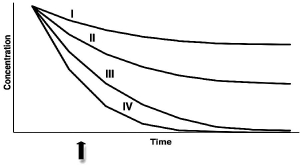
A)I
B)II
C)III
D)IV
E)All have the same rate.

A)I
B)II
C)III
D)IV
E)All have the same rate.

Unlock Deck
Unlock for access to all 155 flashcards in this deck.
Unlock Deck
k this deck
22
In the combustion of methane,  , which reactant has the greatest rate of disappearance?
, which reactant has the greatest rate of disappearance?
A)CH4
B)O2
C)CO2
D)H2O
E)CH4 and O2 have the same rate of disappearance.
 , which reactant has the greatest rate of disappearance?
, which reactant has the greatest rate of disappearance?A)CH4
B)O2
C)CO2
D)H2O
E)CH4 and O2 have the same rate of disappearance.

Unlock Deck
Unlock for access to all 155 flashcards in this deck.
Unlock Deck
k this deck
23
Which of the following is a possible graph of concentration versus time for a reaction product?
A)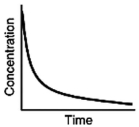
B)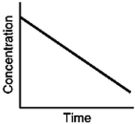
C)
D)
A)

B)

C)

D)


Unlock Deck
Unlock for access to all 155 flashcards in this deck.
Unlock Deck
k this deck
24
A scientist conducts an experiment to determine the rate of NO formation in the reaction:  If the initial concentration of N2 was 0.500 M and the concentration of N2 was 0.450 M after 0.100 s, what is the average rate of NO formation?
If the initial concentration of N2 was 0.500 M and the concentration of N2 was 0.450 M after 0.100 s, what is the average rate of NO formation?
A)0.500 M/s
B)1.00 M/s
C)5.00 M/s
D)10.0 M/s
E)0.250 M/s
 If the initial concentration of N2 was 0.500 M and the concentration of N2 was 0.450 M after 0.100 s, what is the average rate of NO formation?
If the initial concentration of N2 was 0.500 M and the concentration of N2 was 0.450 M after 0.100 s, what is the average rate of NO formation?A)0.500 M/s
B)1.00 M/s
C)5.00 M/s
D)10.0 M/s
E)0.250 M/s

Unlock Deck
Unlock for access to all 155 flashcards in this deck.
Unlock Deck
k this deck
25
The following graph shows the kinetics curves for the reaction of oxygen with hydrogen to form water:  . Which curve is hydrogen?
. Which curve is hydrogen? 
A)the dashed curve
B)the gray curve
C)the black curve
D)either the gray or the black curve
E)Any of these curves could be hydrogen.
 . Which curve is hydrogen?
. Which curve is hydrogen? 
A)the dashed curve
B)the gray curve
C)the black curve
D)either the gray or the black curve
E)Any of these curves could be hydrogen.

Unlock Deck
Unlock for access to all 155 flashcards in this deck.
Unlock Deck
k this deck
26
If the rate of appearance of O2 in the reaction:  is 0.250 M/s over the first 5.50 s, how much oxygen will form during this time?
is 0.250 M/s over the first 5.50 s, how much oxygen will form during this time?
A)1.38 M
B)4.13 M
C)0.69 M
D)0.25 M
E)0.46 M
 is 0.250 M/s over the first 5.50 s, how much oxygen will form during this time?
is 0.250 M/s over the first 5.50 s, how much oxygen will form during this time?A)1.38 M
B)4.13 M
C)0.69 M
D)0.25 M
E)0.46 M

Unlock Deck
Unlock for access to all 155 flashcards in this deck.
Unlock Deck
k this deck
27
If the rate of the reaction:  is 0.870 M/s over the first 12.25 s, how much hydrogen sulfide will be consumed during this time?
is 0.870 M/s over the first 12.25 s, how much hydrogen sulfide will be consumed during this time?
A)10.66 M
B)21.32 M
C)5.33 M
D)31.98 M
E)3.55 M
 is 0.870 M/s over the first 12.25 s, how much hydrogen sulfide will be consumed during this time?
is 0.870 M/s over the first 12.25 s, how much hydrogen sulfide will be consumed during this time?A)10.66 M
B)21.32 M
C)5.33 M
D)31.98 M
E)3.55 M

Unlock Deck
Unlock for access to all 155 flashcards in this deck.
Unlock Deck
k this deck
28
Which of the following is not a possible graph of concentration versus time for a reactant?
A)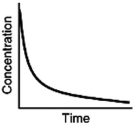
B)
C)
D)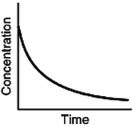
A)

B)

C)

D)


Unlock Deck
Unlock for access to all 155 flashcards in this deck.
Unlock Deck
k this deck
29
From the following concentration versus time plot for four different reactions, which has the greatest instantaneous rate of disappearance at the time indicated by the arrow? 
A)I
B)II
C)III
D)IV
E)All have the same rate of change.

A)I
B)II
C)III
D)IV
E)All have the same rate of change.

Unlock Deck
Unlock for access to all 155 flashcards in this deck.
Unlock Deck
k this deck
30
HI dissociates to form I2 and H2:  If the concentration of HI changes at a rate of -0.45 M/s, what is the rate of appearance of I2(g)?
If the concentration of HI changes at a rate of -0.45 M/s, what is the rate of appearance of I2(g)?
A)0.90 M/s
B)0.45 M/s
C)0.23 M/s
D)1.00 M/s
E)0.13 M/s
 If the concentration of HI changes at a rate of -0.45 M/s, what is the rate of appearance of I2(g)?
If the concentration of HI changes at a rate of -0.45 M/s, what is the rate of appearance of I2(g)?A)0.90 M/s
B)0.45 M/s
C)0.23 M/s
D)1.00 M/s
E)0.13 M/s

Unlock Deck
Unlock for access to all 155 flashcards in this deck.
Unlock Deck
k this deck
31
The following graph shows the kinetics curves for the reaction of oxygen with hydrogen to form water:  . Which curve is water?
. Which curve is water? 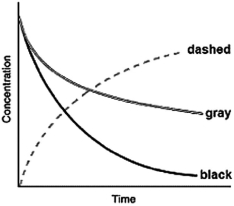
A)the dashed curve
B)the gray curve
C)the black curve
D)either the gray or the black curve
E)Any of these curves could be water.
 . Which curve is water?
. Which curve is water? 
A)the dashed curve
B)the gray curve
C)the black curve
D)either the gray or the black curve
E)Any of these curves could be water.

Unlock Deck
Unlock for access to all 155 flashcards in this deck.
Unlock Deck
k this deck
32
A scientist conducts an experiment to determine the rate of the following reaction:  If the initial concentration of H2 was 0.150 M and the concentration of H2 was 0.050 M after 2.10 s, what is the average rate of the reaction?
If the initial concentration of H2 was 0.150 M and the concentration of H2 was 0.050 M after 2.10 s, what is the average rate of the reaction?
A)0.048 M/s
B)0.016 M/s
C)0.144 M/s
D)0.072 M/s
E)0.032 M/s
 If the initial concentration of H2 was 0.150 M and the concentration of H2 was 0.050 M after 2.10 s, what is the average rate of the reaction?
If the initial concentration of H2 was 0.150 M and the concentration of H2 was 0.050 M after 2.10 s, what is the average rate of the reaction?A)0.048 M/s
B)0.016 M/s
C)0.144 M/s
D)0.072 M/s
E)0.032 M/s

Unlock Deck
Unlock for access to all 155 flashcards in this deck.
Unlock Deck
k this deck
33
If the rate of formation of dinitrogen is 0.540 M/s, what is the rate of formation of water? 
A)0.540 M/s
B)0.180 M/s
C)0.270 M/s
D)1.62 M/s
E)3.24 M/s

A)0.540 M/s
B)0.180 M/s
C)0.270 M/s
D)1.62 M/s
E)3.24 M/s

Unlock Deck
Unlock for access to all 155 flashcards in this deck.
Unlock Deck
k this deck
34
Assuming that each of the following graphs has the same concentration and time axes, which has the greatest initial rate of disappearance of reactant?
A)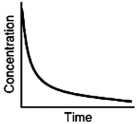
B)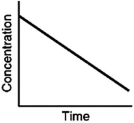
C)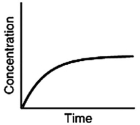
D)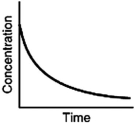
A)

B)

C)

D)


Unlock Deck
Unlock for access to all 155 flashcards in this deck.
Unlock Deck
k this deck
35
A scientist conducts an experiment to determine the rate of the following reaction:  If the initial concentration of NO was 0.00 M and the concentration of NO was 0.050 M after 0.100 s, what is the average rate of the reaction?
If the initial concentration of NO was 0.00 M and the concentration of NO was 0.050 M after 0.100 s, what is the average rate of the reaction?
A)0.500 M/s
B)1.00 M/s
C)5.00 M/s
D)10.0 M/s
E)0.250 M/s
 If the initial concentration of NO was 0.00 M and the concentration of NO was 0.050 M after 0.100 s, what is the average rate of the reaction?
If the initial concentration of NO was 0.00 M and the concentration of NO was 0.050 M after 0.100 s, what is the average rate of the reaction?A)0.500 M/s
B)1.00 M/s
C)5.00 M/s
D)10.0 M/s
E)0.250 M/s

Unlock Deck
Unlock for access to all 155 flashcards in this deck.
Unlock Deck
k this deck
36
If the rate of formation of dinitrogen is 0.540 M/s, what is the rate of disappearance of oxygen? 
A)0.810 M/s
B)1.08 M/s
C)1.62 M/s
D)0.360 M/s
E)0.540 M/s

A)0.810 M/s
B)1.08 M/s
C)1.62 M/s
D)0.360 M/s
E)0.540 M/s

Unlock Deck
Unlock for access to all 155 flashcards in this deck.
Unlock Deck
k this deck
37
If the rate of formation of nitrogen monoxide is 0.413 M/s, what is the rate of disappearance of SO2? 
A)0.207 M/s
B)0.280 M/s
C)0.413 M/s
D)0.620 M/s
E)1.24 M/s

A)0.207 M/s
B)0.280 M/s
C)0.413 M/s
D)0.620 M/s
E)1.24 M/s

Unlock Deck
Unlock for access to all 155 flashcards in this deck.
Unlock Deck
k this deck
38
If the rate of formation of ammonia is 0.345 M/s, what is the rate of disappearance of H2? 
A)0.345 M/s
B)0.230 M/s
C)1.04 M/s
D)0.690 M/s
E)0.518 M/s

A)0.345 M/s
B)0.230 M/s
C)1.04 M/s
D)0.690 M/s
E)0.518 M/s

Unlock Deck
Unlock for access to all 155 flashcards in this deck.
Unlock Deck
k this deck
39
Using the reaction shown below, which statement is correct? 
A)The concentration of all compounds are changing by the same amount at all times.
B)The HCl concentration increases at the same rate as the concentration of iodine.
C)The concentration of hydrogen decreases at the same rate as the concentration of ICl.
D)The concentration of HCl increases twice as fast as the concentration of iodine.
E)None of these statements is correct.

A)The concentration of all compounds are changing by the same amount at all times.
B)The HCl concentration increases at the same rate as the concentration of iodine.
C)The concentration of hydrogen decreases at the same rate as the concentration of ICl.
D)The concentration of HCl increases twice as fast as the concentration of iodine.
E)None of these statements is correct.

Unlock Deck
Unlock for access to all 155 flashcards in this deck.
Unlock Deck
k this deck
40
If the rate of formation of ammonia is 0.345 M/s, what is the rate of disappearance of N2? 
A)0.173 M/s
B)0.345 M/s
C)0.690 M/s
D)245 M/s
E)0.518 M/s

A)0.173 M/s
B)0.345 M/s
C)0.690 M/s
D)245 M/s
E)0.518 M/s

Unlock Deck
Unlock for access to all 155 flashcards in this deck.
Unlock Deck
k this deck
41
The rate law of a particular reaction was determined to be Rate = k. What is the unit of the rate constant for the reaction?
A)M/s
B)1/(Ms)
C)1/(Ms2)
D)1/s
E)Ms
A)M/s
B)1/(Ms)
C)1/(Ms2)
D)1/s
E)Ms

Unlock Deck
Unlock for access to all 155 flashcards in this deck.
Unlock Deck
k this deck
42
For the rate law Rate = k[A][B]1/2, the partial order with respect to A is ________, the partial order with respect to B is ________, and the total order is ________.
A)![<strong>For the rate law Rate = k[A][B]<sup>1/2</sup>, the partial order with respect to A is ________, the partial order with respect to B is ________, and the total order is ________.</strong> A) B) C) D) E)The orders cannot be determined without a chemical reaction.](https://d2lvgg3v3hfg70.cloudfront.net/TB3835/11eaa952_9b6a_2af3_ae90_f54fda7912bb_TB3835_11.jpg)
B)![<strong>For the rate law Rate = k[A][B]<sup>1/2</sup>, the partial order with respect to A is ________, the partial order with respect to B is ________, and the total order is ________.</strong> A) B) C) D) E)The orders cannot be determined without a chemical reaction.](https://d2lvgg3v3hfg70.cloudfront.net/TB3835/11eaa952_9b6a_2af4_ae90_cd6e393b7e5b_TB3835_11.jpg)
C)![<strong>For the rate law Rate = k[A][B]<sup>1/2</sup>, the partial order with respect to A is ________, the partial order with respect to B is ________, and the total order is ________.</strong> A) B) C) D) E)The orders cannot be determined without a chemical reaction.](https://d2lvgg3v3hfg70.cloudfront.net/TB3835/11eaa952_9b6a_5205_ae90_0f96735821ed_TB3835_11.jpg)
D)![<strong>For the rate law Rate = k[A][B]<sup>1/2</sup>, the partial order with respect to A is ________, the partial order with respect to B is ________, and the total order is ________.</strong> A) B) C) D) E)The orders cannot be determined without a chemical reaction.](https://d2lvgg3v3hfg70.cloudfront.net/TB3835/11eaa952_9b6a_5206_ae90_e39c2c3556c0_TB3835_11.jpg)
E)The orders cannot be determined without a chemical reaction.
A)
![<strong>For the rate law Rate = k[A][B]<sup>1/2</sup>, the partial order with respect to A is ________, the partial order with respect to B is ________, and the total order is ________.</strong> A) B) C) D) E)The orders cannot be determined without a chemical reaction.](https://d2lvgg3v3hfg70.cloudfront.net/TB3835/11eaa952_9b6a_2af3_ae90_f54fda7912bb_TB3835_11.jpg)
B)
![<strong>For the rate law Rate = k[A][B]<sup>1/2</sup>, the partial order with respect to A is ________, the partial order with respect to B is ________, and the total order is ________.</strong> A) B) C) D) E)The orders cannot be determined without a chemical reaction.](https://d2lvgg3v3hfg70.cloudfront.net/TB3835/11eaa952_9b6a_2af4_ae90_cd6e393b7e5b_TB3835_11.jpg)
C)
![<strong>For the rate law Rate = k[A][B]<sup>1/2</sup>, the partial order with respect to A is ________, the partial order with respect to B is ________, and the total order is ________.</strong> A) B) C) D) E)The orders cannot be determined without a chemical reaction.](https://d2lvgg3v3hfg70.cloudfront.net/TB3835/11eaa952_9b6a_5205_ae90_0f96735821ed_TB3835_11.jpg)
D)
![<strong>For the rate law Rate = k[A][B]<sup>1/2</sup>, the partial order with respect to A is ________, the partial order with respect to B is ________, and the total order is ________.</strong> A) B) C) D) E)The orders cannot be determined without a chemical reaction.](https://d2lvgg3v3hfg70.cloudfront.net/TB3835/11eaa952_9b6a_5206_ae90_e39c2c3556c0_TB3835_11.jpg)
E)The orders cannot be determined without a chemical reaction.

Unlock Deck
Unlock for access to all 155 flashcards in this deck.
Unlock Deck
k this deck
43
The half-life (t1/2) of a first-order reaction is 0.100 s. What is the rate constant?
A)6.93 s-1
B)0.693 s-1
C)0.0693 s-1
D)0.144 s-1
E)3.01 s-1
A)6.93 s-1
B)0.693 s-1
C)0.0693 s-1
D)0.144 s-1
E)3.01 s-1

Unlock Deck
Unlock for access to all 155 flashcards in this deck.
Unlock Deck
k this deck
44
In a rate law, the partial orders are determined by ________
A)the reactant concentrations.
B)the stoichiometric coefficients.
C)the product concentrations.
D)experiment.
E)the difference between the forward and reverse rates.
A)the reactant concentrations.
B)the stoichiometric coefficients.
C)the product concentrations.
D)experiment.
E)the difference between the forward and reverse rates.

Unlock Deck
Unlock for access to all 155 flashcards in this deck.
Unlock Deck
k this deck
45
If the reaction 3A + B +  C
C  2D + E is first order overall, which of these could be the units of its rate constant, k?
2D + E is first order overall, which of these could be the units of its rate constant, k?
A)1/s
B)M/s
C)1/Ms
D)1/Ms2
E)Ms
 C
C  2D + E is first order overall, which of these could be the units of its rate constant, k?
2D + E is first order overall, which of these could be the units of its rate constant, k?A)1/s
B)M/s
C)1/Ms
D)1/Ms2
E)Ms

Unlock Deck
Unlock for access to all 155 flashcards in this deck.
Unlock Deck
k this deck
46
In a first order reaction, the initial concentration of A is 0.40 M. What is the concentration of A after 15 seconds if the half-life of the reaction is 3 seconds?
A)8.0 10-2 M
B)2.0 M
C)5.0 10-2 M
D)2.5 10-2 M
E)1.3 10-2 M
A)8.0 10-2 M
B)2.0 M
C)5.0 10-2 M
D)2.5 10-2 M
E)1.3 10-2 M

Unlock Deck
Unlock for access to all 155 flashcards in this deck.
Unlock Deck
k this deck
47
A second-order reaction (2A ![<strong>A second-order reaction (2A B) with a rate constant of 0.350 M <sup>-1</sup>s <sup>-1</sup> is found to have a half-life of 3.45 s. What was the initial concentration of the reactant, [A]<sub>0</sub>?</strong> A)0.828 M B)0.201 M C)1.00 M D)1.21 M E)0.350 M](https://d2lvgg3v3hfg70.cloudfront.net/TB3835/11eaa952_9b6b_b1a1_ae90_bdd2d6855e38_TB3835_11.jpg) B) with a rate constant of 0.350 M -1s -1 is found to have a half-life of 3.45 s. What was the initial concentration of the reactant, [A]0?
B) with a rate constant of 0.350 M -1s -1 is found to have a half-life of 3.45 s. What was the initial concentration of the reactant, [A]0?
A)0.828 M
B)0.201 M
C)1.00 M
D)1.21 M
E)0.350 M
![<strong>A second-order reaction (2A B) with a rate constant of 0.350 M <sup>-1</sup>s <sup>-1</sup> is found to have a half-life of 3.45 s. What was the initial concentration of the reactant, [A]<sub>0</sub>?</strong> A)0.828 M B)0.201 M C)1.00 M D)1.21 M E)0.350 M](https://d2lvgg3v3hfg70.cloudfront.net/TB3835/11eaa952_9b6b_b1a1_ae90_bdd2d6855e38_TB3835_11.jpg) B) with a rate constant of 0.350 M -1s -1 is found to have a half-life of 3.45 s. What was the initial concentration of the reactant, [A]0?
B) with a rate constant of 0.350 M -1s -1 is found to have a half-life of 3.45 s. What was the initial concentration of the reactant, [A]0?A)0.828 M
B)0.201 M
C)1.00 M
D)1.21 M
E)0.350 M

Unlock Deck
Unlock for access to all 155 flashcards in this deck.
Unlock Deck
k this deck
48
The reaction A(g) + B(g) ![<strong>The reaction A(g) + B(g) C(g) has the following rate law: Rate = k[A]<sup>2</sup>[B]. If the concentration of A is tripled while the concentration of B is doubled, the rate will increase by a factor of ________.</strong> A)9 B)18 C)12 D)6 E)24](https://d2lvgg3v3hfg70.cloudfront.net/TB3835/11eaa952_9b6b_d8b3_ae90_cf409b8d6e45_TB3835_11.jpg) C(g) has the following rate law: Rate = k[A]2[B]. If the concentration of A is tripled while the concentration of B is doubled, the rate will increase by a factor of ________.
C(g) has the following rate law: Rate = k[A]2[B]. If the concentration of A is tripled while the concentration of B is doubled, the rate will increase by a factor of ________.
A)9
B)18
C)12
D)6
E)24
![<strong>The reaction A(g) + B(g) C(g) has the following rate law: Rate = k[A]<sup>2</sup>[B]. If the concentration of A is tripled while the concentration of B is doubled, the rate will increase by a factor of ________.</strong> A)9 B)18 C)12 D)6 E)24](https://d2lvgg3v3hfg70.cloudfront.net/TB3835/11eaa952_9b6b_d8b3_ae90_cf409b8d6e45_TB3835_11.jpg) C(g) has the following rate law: Rate = k[A]2[B]. If the concentration of A is tripled while the concentration of B is doubled, the rate will increase by a factor of ________.
C(g) has the following rate law: Rate = k[A]2[B]. If the concentration of A is tripled while the concentration of B is doubled, the rate will increase by a factor of ________.A)9
B)18
C)12
D)6
E)24

Unlock Deck
Unlock for access to all 155 flashcards in this deck.
Unlock Deck
k this deck
49
If the rate of formation of ammonia is 0.345 M/s, what is the rate of disappearance of N2? 
A)0.173 M/s
B)0.345 M/s
C)0.690 M/s
D)245 M/s
E)0.518 M/s

A)0.173 M/s
B)0.345 M/s
C)0.690 M/s
D)245 M/s
E)0.518 M/s

Unlock Deck
Unlock for access to all 155 flashcards in this deck.
Unlock Deck
k this deck
50
The reaction  is first order in B and A. The overall order of the reaction is ________
is first order in B and A. The overall order of the reaction is ________
A)first.
B)second.
C)third.
D)zero.
E)fourth.
 is first order in B and A. The overall order of the reaction is ________
is first order in B and A. The overall order of the reaction is ________A)first.
B)second.
C)third.
D)zero.
E)fourth.

Unlock Deck
Unlock for access to all 155 flashcards in this deck.
Unlock Deck
k this deck
51
Ammonia gas (NH3) is produced from hydrogen and nitrogen gas according to the following reaction:  If the rate of production of ammonia is R(NH3), what is the rate of loss of hydrogen and nitrogen gas, respectively?
If the rate of production of ammonia is R(NH3), what is the rate of loss of hydrogen and nitrogen gas, respectively?
A)(-R(H2) = 2/3 R(NH3); -R(N2) = 1/2 R(NH3))
B)(-R(H2) = 3/2 R(NH3); -R(N2) = 2 R(NH3))
C)(-R(H2) = 3/2 R(NH3); -R(N2) = 1/2 R(NH3))
D)(-R(H2) = 2/3 R(NH3); -R(N2) = 2 R(NH3))
E)(-R(H2) = R(NH3); -R(N2) = R(NH3))
 If the rate of production of ammonia is R(NH3), what is the rate of loss of hydrogen and nitrogen gas, respectively?
If the rate of production of ammonia is R(NH3), what is the rate of loss of hydrogen and nitrogen gas, respectively?A)(-R(H2) = 2/3 R(NH3); -R(N2) = 1/2 R(NH3))
B)(-R(H2) = 3/2 R(NH3); -R(N2) = 2 R(NH3))
C)(-R(H2) = 3/2 R(NH3); -R(N2) = 1/2 R(NH3))
D)(-R(H2) = 2/3 R(NH3); -R(N2) = 2 R(NH3))
E)(-R(H2) = R(NH3); -R(N2) = R(NH3))

Unlock Deck
Unlock for access to all 155 flashcards in this deck.
Unlock Deck
k this deck
52
The reaction A(g) + B(g) ![<strong>The reaction A(g) + B(g) C(g) has the following rate law: Rate = k[A]<sup>1/2</sup>[B]<sup>2</sup>. If the concentration of A is quadrupled while the concentration of B is halved, the rate will change by a factor of ________.</strong> A)0.25 B)0.50 C)2 D)4 E)16](https://d2lvgg3v3hfg70.cloudfront.net/TB3835/11eaa952_9b6b_ffc4_ae90_718507ae4571_TB3835_11.jpg) C(g) has the following rate law: Rate = k[A]1/2[B]2. If the concentration of A is quadrupled while the concentration of B is halved, the rate will change by a factor of ________.
C(g) has the following rate law: Rate = k[A]1/2[B]2. If the concentration of A is quadrupled while the concentration of B is halved, the rate will change by a factor of ________.
A)0.25
B)0.50
C)2
D)4
E)16
![<strong>The reaction A(g) + B(g) C(g) has the following rate law: Rate = k[A]<sup>1/2</sup>[B]<sup>2</sup>. If the concentration of A is quadrupled while the concentration of B is halved, the rate will change by a factor of ________.</strong> A)0.25 B)0.50 C)2 D)4 E)16](https://d2lvgg3v3hfg70.cloudfront.net/TB3835/11eaa952_9b6b_ffc4_ae90_718507ae4571_TB3835_11.jpg) C(g) has the following rate law: Rate = k[A]1/2[B]2. If the concentration of A is quadrupled while the concentration of B is halved, the rate will change by a factor of ________.
C(g) has the following rate law: Rate = k[A]1/2[B]2. If the concentration of A is quadrupled while the concentration of B is halved, the rate will change by a factor of ________.A)0.25
B)0.50
C)2
D)4
E)16

Unlock Deck
Unlock for access to all 155 flashcards in this deck.
Unlock Deck
k this deck
53
A reaction is first order in A. If the rate constant of the reaction is 3.45 10-3 s-1, what is the half-life (t1/2) of the reaction?
A)4.98 10-3 s
B)200 s
C)3.45 10-3 s
D)100 s
E)1.73 10-3 s
A)4.98 10-3 s
B)200 s
C)3.45 10-3 s
D)100 s
E)1.73 10-3 s

Unlock Deck
Unlock for access to all 155 flashcards in this deck.
Unlock Deck
k this deck
54
For the rate law Rate = k[A]1/2[B], the partial order with respect to A is ________, the partial order with respect to B is ________, and the total order is ________.
A)![<strong>For the rate law Rate = k[A]<sup>1/2</sup>[B], the partial order with respect to A is ________, the partial order with respect to B is ________, and the total order is ________.</strong> A) B) C) D) E)The orders cannot be determined without a chemical reaction.](https://d2lvgg3v3hfg70.cloudfront.net/TB3835/11eaa952_9b6a_7917_ae90_0bc0b1ad28e8_TB3835_11.jpg)
B)![<strong>For the rate law Rate = k[A]<sup>1/2</sup>[B], the partial order with respect to A is ________, the partial order with respect to B is ________, and the total order is ________.</strong> A) B) C) D) E)The orders cannot be determined without a chemical reaction.](https://d2lvgg3v3hfg70.cloudfront.net/TB3835/11eaa952_9b6a_7918_ae90_59c9206c0131_TB3835_11.jpg)
C)![<strong>For the rate law Rate = k[A]<sup>1/2</sup>[B], the partial order with respect to A is ________, the partial order with respect to B is ________, and the total order is ________.</strong> A) B) C) D) E)The orders cannot be determined without a chemical reaction.](https://d2lvgg3v3hfg70.cloudfront.net/TB3835/11eaa952_9b6a_a029_ae90_4f4650bda2c8_TB3835_11.jpg)
D)![<strong>For the rate law Rate = k[A]<sup>1/2</sup>[B], the partial order with respect to A is ________, the partial order with respect to B is ________, and the total order is ________.</strong> A) B) C) D) E)The orders cannot be determined without a chemical reaction.](https://d2lvgg3v3hfg70.cloudfront.net/TB3835/11eaa952_9b6a_a02a_ae90_711125363a67_TB3835_11.jpg)
E)The orders cannot be determined without a chemical reaction.
A)
![<strong>For the rate law Rate = k[A]<sup>1/2</sup>[B], the partial order with respect to A is ________, the partial order with respect to B is ________, and the total order is ________.</strong> A) B) C) D) E)The orders cannot be determined without a chemical reaction.](https://d2lvgg3v3hfg70.cloudfront.net/TB3835/11eaa952_9b6a_7917_ae90_0bc0b1ad28e8_TB3835_11.jpg)
B)
![<strong>For the rate law Rate = k[A]<sup>1/2</sup>[B], the partial order with respect to A is ________, the partial order with respect to B is ________, and the total order is ________.</strong> A) B) C) D) E)The orders cannot be determined without a chemical reaction.](https://d2lvgg3v3hfg70.cloudfront.net/TB3835/11eaa952_9b6a_7918_ae90_59c9206c0131_TB3835_11.jpg)
C)
![<strong>For the rate law Rate = k[A]<sup>1/2</sup>[B], the partial order with respect to A is ________, the partial order with respect to B is ________, and the total order is ________.</strong> A) B) C) D) E)The orders cannot be determined without a chemical reaction.](https://d2lvgg3v3hfg70.cloudfront.net/TB3835/11eaa952_9b6a_a029_ae90_4f4650bda2c8_TB3835_11.jpg)
D)
![<strong>For the rate law Rate = k[A]<sup>1/2</sup>[B], the partial order with respect to A is ________, the partial order with respect to B is ________, and the total order is ________.</strong> A) B) C) D) E)The orders cannot be determined without a chemical reaction.](https://d2lvgg3v3hfg70.cloudfront.net/TB3835/11eaa952_9b6a_a02a_ae90_711125363a67_TB3835_11.jpg)
E)The orders cannot be determined without a chemical reaction.

Unlock Deck
Unlock for access to all 155 flashcards in this deck.
Unlock Deck
k this deck
55
For the rate law Rate = k[A]5/2[B], the partial order with respect to A is ________, the partial order with respect to B is ________, and the total order is ________.
A)![<strong>For the rate law Rate = k[A]<sup>5/2</sup>[B], the partial order with respect to A is ________, the partial order with respect to B is ________, and the total order is ________.</strong> A) B) C) D) E)The orders cannot be determined without a chemical reaction.](https://d2lvgg3v3hfg70.cloudfront.net/TB3835/11eaa952_9b6a_c73b_ae90_abbf8d494955_TB3835_11.jpg)
B)![<strong>For the rate law Rate = k[A]<sup>5/2</sup>[B], the partial order with respect to A is ________, the partial order with respect to B is ________, and the total order is ________.</strong> A) B) C) D) E)The orders cannot be determined without a chemical reaction.](https://d2lvgg3v3hfg70.cloudfront.net/TB3835/11eaa952_9b6a_c73c_ae90_2751ad9d2dda_TB3835_11.jpg)
C)![<strong>For the rate law Rate = k[A]<sup>5/2</sup>[B], the partial order with respect to A is ________, the partial order with respect to B is ________, and the total order is ________.</strong> A) B) C) D) E)The orders cannot be determined without a chemical reaction.](https://d2lvgg3v3hfg70.cloudfront.net/TB3835/11eaa952_9b6a_ee4d_ae90_fb79a904d3a4_TB3835_11.jpg)
D)![<strong>For the rate law Rate = k[A]<sup>5/2</sup>[B], the partial order with respect to A is ________, the partial order with respect to B is ________, and the total order is ________.</strong> A) B) C) D) E)The orders cannot be determined without a chemical reaction.](https://d2lvgg3v3hfg70.cloudfront.net/TB3835/11eaa952_9b6a_ee4e_ae90_5113dbfb0d43_TB3835_11.jpg)
E)The orders cannot be determined without a chemical reaction.
A)
![<strong>For the rate law Rate = k[A]<sup>5/2</sup>[B], the partial order with respect to A is ________, the partial order with respect to B is ________, and the total order is ________.</strong> A) B) C) D) E)The orders cannot be determined without a chemical reaction.](https://d2lvgg3v3hfg70.cloudfront.net/TB3835/11eaa952_9b6a_c73b_ae90_abbf8d494955_TB3835_11.jpg)
B)
![<strong>For the rate law Rate = k[A]<sup>5/2</sup>[B], the partial order with respect to A is ________, the partial order with respect to B is ________, and the total order is ________.</strong> A) B) C) D) E)The orders cannot be determined without a chemical reaction.](https://d2lvgg3v3hfg70.cloudfront.net/TB3835/11eaa952_9b6a_c73c_ae90_2751ad9d2dda_TB3835_11.jpg)
C)
![<strong>For the rate law Rate = k[A]<sup>5/2</sup>[B], the partial order with respect to A is ________, the partial order with respect to B is ________, and the total order is ________.</strong> A) B) C) D) E)The orders cannot be determined without a chemical reaction.](https://d2lvgg3v3hfg70.cloudfront.net/TB3835/11eaa952_9b6a_ee4d_ae90_fb79a904d3a4_TB3835_11.jpg)
D)
![<strong>For the rate law Rate = k[A]<sup>5/2</sup>[B], the partial order with respect to A is ________, the partial order with respect to B is ________, and the total order is ________.</strong> A) B) C) D) E)The orders cannot be determined without a chemical reaction.](https://d2lvgg3v3hfg70.cloudfront.net/TB3835/11eaa952_9b6a_ee4e_ae90_5113dbfb0d43_TB3835_11.jpg)
E)The orders cannot be determined without a chemical reaction.

Unlock Deck
Unlock for access to all 155 flashcards in this deck.
Unlock Deck
k this deck
56
The second-order reaction A ![<strong>The second-order reaction A B is found to have a rate constant of 0.978 M <sup>-1</sup>s <sup>-1</sup>. What is the half-life of this reaction when [A]<sub>0</sub> = 0.0300 M ?</strong> A)0.0293 s B)0.710 s C)34.1 s D)60.1 s E)24.3 s](https://d2lvgg3v3hfg70.cloudfront.net/TB3835/11eaa952_9b6b_b1a2_ae90_133f4633accb_TB3835_11.jpg) B is found to have a rate constant of 0.978 M -1s -1. What is the half-life of this reaction when [A]0 = 0.0300 M ?
B is found to have a rate constant of 0.978 M -1s -1. What is the half-life of this reaction when [A]0 = 0.0300 M ?
A)0.0293 s
B)0.710 s
C)34.1 s
D)60.1 s
E)24.3 s
![<strong>The second-order reaction A B is found to have a rate constant of 0.978 M <sup>-1</sup>s <sup>-1</sup>. What is the half-life of this reaction when [A]<sub>0</sub> = 0.0300 M ?</strong> A)0.0293 s B)0.710 s C)34.1 s D)60.1 s E)24.3 s](https://d2lvgg3v3hfg70.cloudfront.net/TB3835/11eaa952_9b6b_b1a2_ae90_133f4633accb_TB3835_11.jpg) B is found to have a rate constant of 0.978 M -1s -1. What is the half-life of this reaction when [A]0 = 0.0300 M ?
B is found to have a rate constant of 0.978 M -1s -1. What is the half-life of this reaction when [A]0 = 0.0300 M ?A)0.0293 s
B)0.710 s
C)34.1 s
D)60.1 s
E)24.3 s

Unlock Deck
Unlock for access to all 155 flashcards in this deck.
Unlock Deck
k this deck
57
The rate law of a particular reaction was determined to be Rate = k[A][B]. What is the unit of the rate constant for the reaction?
A)M/s
B)1/(Ms)
C)1/(Ms2)
D)1/s
E)Ms
A)M/s
B)1/(Ms)
C)1/(Ms2)
D)1/s
E)Ms

Unlock Deck
Unlock for access to all 155 flashcards in this deck.
Unlock Deck
k this deck
58
The reaction CHCl3(g) + Cl2(g) ![<strong>The reaction CHCl<sub>3</sub>(g) + Cl<sub>2</sub>(g) CCl<sub>4</sub>(g) + HCl(g) has the following rate law: Rate = k[CHCl<sub>3</sub>][Cl<sub>2</sub>]. If the concentration of CHCl<sub>3</sub> is increased by a factor of five while the concentration of Cl<sub>2</sub> is kept the same, the rate will ________</strong> A)double. B)triple. C)stay the same. D)increase by a factor of five. E)decrease by a factor of one-fifth.](https://d2lvgg3v3hfg70.cloudfront.net/TB3835/11eaa952_9b6c_26d5_ae90_0331cf07d3d3_TB3835_11.jpg) CCl4(g) + HCl(g) has the following rate law: Rate = k[CHCl3][Cl2]. If the concentration of CHCl3 is increased by a factor of five while the concentration of Cl2 is kept the same, the rate will ________
CCl4(g) + HCl(g) has the following rate law: Rate = k[CHCl3][Cl2]. If the concentration of CHCl3 is increased by a factor of five while the concentration of Cl2 is kept the same, the rate will ________
A)double.
B)triple.
C)stay the same.
D)increase by a factor of five.
E)decrease by a factor of one-fifth.
![<strong>The reaction CHCl<sub>3</sub>(g) + Cl<sub>2</sub>(g) CCl<sub>4</sub>(g) + HCl(g) has the following rate law: Rate = k[CHCl<sub>3</sub>][Cl<sub>2</sub>]. If the concentration of CHCl<sub>3</sub> is increased by a factor of five while the concentration of Cl<sub>2</sub> is kept the same, the rate will ________</strong> A)double. B)triple. C)stay the same. D)increase by a factor of five. E)decrease by a factor of one-fifth.](https://d2lvgg3v3hfg70.cloudfront.net/TB3835/11eaa952_9b6c_26d5_ae90_0331cf07d3d3_TB3835_11.jpg) CCl4(g) + HCl(g) has the following rate law: Rate = k[CHCl3][Cl2]. If the concentration of CHCl3 is increased by a factor of five while the concentration of Cl2 is kept the same, the rate will ________
CCl4(g) + HCl(g) has the following rate law: Rate = k[CHCl3][Cl2]. If the concentration of CHCl3 is increased by a factor of five while the concentration of Cl2 is kept the same, the rate will ________A)double.
B)triple.
C)stay the same.
D)increase by a factor of five.
E)decrease by a factor of one-fifth.

Unlock Deck
Unlock for access to all 155 flashcards in this deck.
Unlock Deck
k this deck
59
The disappearance of HI in the reaction ![<strong>The disappearance of HI in the reaction is shown in the following figure. What is the instantaneous rate of this reaction at t = 5 s if the instantaneous rate of change of [HI] is 0.02 M/s? </strong> A)0.2 M/s B)0.01 M/s C)0.02 M/s D)0.100 M/s E)0.04 M/s](https://d2lvgg3v3hfg70.cloudfront.net/TB3835/11eaa952_9b69_dcd0_ae90_09e3cbbd1fc7_TB3835_11.jpg) is shown in the following figure. What is the instantaneous rate of this reaction at t = 5 s if the instantaneous rate of change of [HI] is 0.02 M/s?
is shown in the following figure. What is the instantaneous rate of this reaction at t = 5 s if the instantaneous rate of change of [HI] is 0.02 M/s? ![<strong>The disappearance of HI in the reaction is shown in the following figure. What is the instantaneous rate of this reaction at t = 5 s if the instantaneous rate of change of [HI] is 0.02 M/s? </strong> A)0.2 M/s B)0.01 M/s C)0.02 M/s D)0.100 M/s E)0.04 M/s](https://d2lvgg3v3hfg70.cloudfront.net/TB3835/11eaa952_9b69_dcd1_ae90_8bb11f7c3a0d_TB3835_00.jpg)
A)0.2 M/s
B)0.01 M/s
C)0.02 M/s
D)0.100 M/s
E)0.04 M/s
![<strong>The disappearance of HI in the reaction is shown in the following figure. What is the instantaneous rate of this reaction at t = 5 s if the instantaneous rate of change of [HI] is 0.02 M/s? </strong> A)0.2 M/s B)0.01 M/s C)0.02 M/s D)0.100 M/s E)0.04 M/s](https://d2lvgg3v3hfg70.cloudfront.net/TB3835/11eaa952_9b69_dcd0_ae90_09e3cbbd1fc7_TB3835_11.jpg) is shown in the following figure. What is the instantaneous rate of this reaction at t = 5 s if the instantaneous rate of change of [HI] is 0.02 M/s?
is shown in the following figure. What is the instantaneous rate of this reaction at t = 5 s if the instantaneous rate of change of [HI] is 0.02 M/s? ![<strong>The disappearance of HI in the reaction is shown in the following figure. What is the instantaneous rate of this reaction at t = 5 s if the instantaneous rate of change of [HI] is 0.02 M/s? </strong> A)0.2 M/s B)0.01 M/s C)0.02 M/s D)0.100 M/s E)0.04 M/s](https://d2lvgg3v3hfg70.cloudfront.net/TB3835/11eaa952_9b69_dcd1_ae90_8bb11f7c3a0d_TB3835_00.jpg)
A)0.2 M/s
B)0.01 M/s
C)0.02 M/s
D)0.100 M/s
E)0.04 M/s

Unlock Deck
Unlock for access to all 155 flashcards in this deck.
Unlock Deck
k this deck
60
Which of these could be the units of the rate constant for a first-order reaction?
A)M/s
B)1/Ms
C)1/Ms2
D)1/s
E)Ms
A)M/s
B)1/Ms
C)1/Ms2
D)1/s
E)Ms

Unlock Deck
Unlock for access to all 155 flashcards in this deck.
Unlock Deck
k this deck
61
Which of the following plots indicates that the reaction is second order?
A)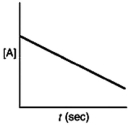
B)
C)
D)
A)

B)

C)

D)


Unlock Deck
Unlock for access to all 155 flashcards in this deck.
Unlock Deck
k this deck
62
Which of the following plots would indicate that a reaction was first order?
A)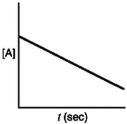
B)
C)
D)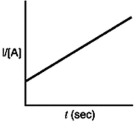
A)

B)

C)

D)


Unlock Deck
Unlock for access to all 155 flashcards in this deck.
Unlock Deck
k this deck
63
The linear form of the Arrhenius equation is very useful, as it allows us to calculate the ________ from the slope and the ________ from the intercept.
A)frequency factor; activation energy
B)initial concentration; activation energy
C)activation energy; frequency factor
D)activation energy; Boltzmann constant
E)transition state; steric factor
A)frequency factor; activation energy
B)initial concentration; activation energy
C)activation energy; frequency factor
D)activation energy; Boltzmann constant
E)transition state; steric factor

Unlock Deck
Unlock for access to all 155 flashcards in this deck.
Unlock Deck
k this deck
64
Which of the following plots indicates that the reaction is zero order?
A)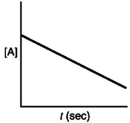
B)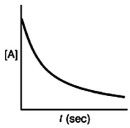
C)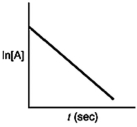
D)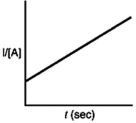
A)

B)

C)

D)


Unlock Deck
Unlock for access to all 155 flashcards in this deck.
Unlock Deck
k this deck
65
Chlorine dioxide (ClO2) is used as a disinfectant in municipal water-treatment plants. It decomposes in a first-order reaction with a rate constant of 0.0714 s-1. If the initial concentration were 0.12 M, what would the concentration be after 14.0 s has elapsed?
A)0.033 M
B)0.12 M
C)0.060 M
D)0.012 M
E)0.044 M
A)0.033 M
B)0.12 M
C)0.060 M
D)0.012 M
E)0.044 M

Unlock Deck
Unlock for access to all 155 flashcards in this deck.
Unlock Deck
k this deck
66
Which plot would provide the activation energy for a reaction?
A)
B)
C)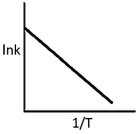
D)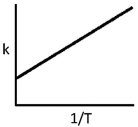
A)

B)

C)

D)


Unlock Deck
Unlock for access to all 155 flashcards in this deck.
Unlock Deck
k this deck
67
N2O5 is used as a source of NO2 in chemical reactions. The compound decomposes in a first order reaction. If the initial concentration of N2O5 = 0.400 M, and the concentration is 0.025 M after 120 seconds, what is the rate constant k of the reaction?
A)7.50 s-1
B)333 s-1
C)2.77 s-1
D)2.31 10-2 s-1
E)5.21 10-4 s-1
A)7.50 s-1
B)333 s-1
C)2.77 s-1
D)2.31 10-2 s-1
E)5.21 10-4 s-1

Unlock Deck
Unlock for access to all 155 flashcards in this deck.
Unlock Deck
k this deck
68
Which point in the reaction profile below represents a transition state? 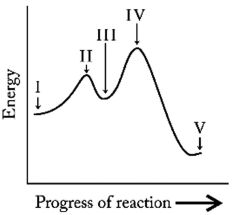
A)II and IV
B)II only
C)III
D)IV only
E)V

A)II and IV
B)II only
C)III
D)IV only
E)V

Unlock Deck
Unlock for access to all 155 flashcards in this deck.
Unlock Deck
k this deck
69
How many steps are involved in the following reaction? 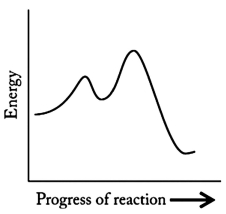
A)None
B)One
C)Two
D)three
E)cannot be determined

A)None
B)One
C)Two
D)three
E)cannot be determined

Unlock Deck
Unlock for access to all 155 flashcards in this deck.
Unlock Deck
k this deck
70
Which point as labeled by an asterisk (*) on the following energy profile is the transition state?
A)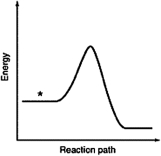
B)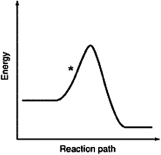
C)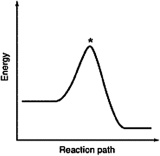
D)
A)

B)

C)

D)


Unlock Deck
Unlock for access to all 155 flashcards in this deck.
Unlock Deck
k this deck
71
The energy profiles for four different reactions are shown below. The scales are the same for each. Which reaction requires the most energetic collisions to reach the transition state? 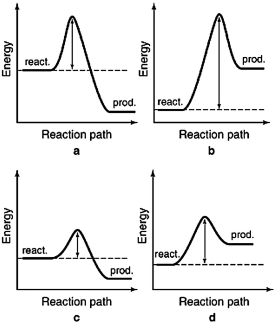
A)a
B)b
C)c
D)d

A)a
B)b
C)c
D)d

Unlock Deck
Unlock for access to all 155 flashcards in this deck.
Unlock Deck
k this deck
72
The energy profiles for four different reactions are shown below. The scales are the same for each. Which reaction requires the least energetic collisions to reach the transition state? 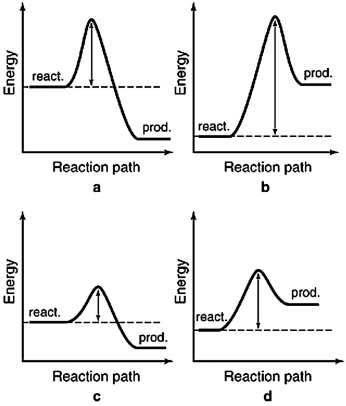
A)a
B)b
C)c
D)d

A)a
B)b
C)c
D)d

Unlock Deck
Unlock for access to all 155 flashcards in this deck.
Unlock Deck
k this deck
73
Collision theory assumes that the rate of a reaction depends on ________
A)the energy of collisions.
B)the orientation of colliding molecules.
C)the energy of collisions and the orientation of colliding molecules.
D)the change in energy between the products and the reactants.
E)the change in free energy between the reactants and products.
A)the energy of collisions.
B)the orientation of colliding molecules.
C)the energy of collisions and the orientation of colliding molecules.
D)the change in energy between the products and the reactants.
E)the change in free energy between the reactants and products.

Unlock Deck
Unlock for access to all 155 flashcards in this deck.
Unlock Deck
k this deck
74
Which point in the reaction profile below represents an intermediate? 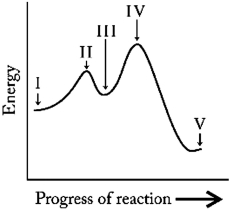
A)II and IV
B)II only
C)III
D)IV only
E)V

A)II and IV
B)II only
C)III
D)IV only
E)V

Unlock Deck
Unlock for access to all 155 flashcards in this deck.
Unlock Deck
k this deck
75
The energy needed to form an activated complex is called ________
A)collision energy.
B)kinetic energy.
C)activation energy.
D)potential energy.
E)thermodynamic energy.
A)collision energy.
B)kinetic energy.
C)activation energy.
D)potential energy.
E)thermodynamic energy.

Unlock Deck
Unlock for access to all 155 flashcards in this deck.
Unlock Deck
k this deck
76
Sodium hypochlorite (NaClO) is used as a common disinfectant. It decomposes in a first-order process with a rate constant of 0.10 s-1. How long would it take for an initial concentration of 0.20 M to decrease to 0.07 M ?
A)0.50 s
B)5.43 s
C)10.5 s
D)35.7 s
E)92.9 s
A)0.50 s
B)5.43 s
C)10.5 s
D)35.7 s
E)92.9 s

Unlock Deck
Unlock for access to all 155 flashcards in this deck.
Unlock Deck
k this deck
77
Consider the rate law expression Rate = k[A][B]2. Which of the following is not true about the reaction?
A)The reaction is second order in B.
B)The reaction is first order in A.
C)The reaction is overall third order.
D)Doubling the concentration of B will double the rate.
E)All statements (A-D) are true.
A)The reaction is second order in B.
B)The reaction is first order in A.
C)The reaction is overall third order.
D)Doubling the concentration of B will double the rate.
E)All statements (A-D) are true.

Unlock Deck
Unlock for access to all 155 flashcards in this deck.
Unlock Deck
k this deck
78
The first-order reaction A ![<strong>The first-order reaction A B, has k = 5.67 s<sup>-1</sup>. If [A]<sub>0</sub> = 0.500 M, how long will it take to reach [A] = 0.124 M ?</strong> A)0.122 s B)0.100 s C)8.18 s D)0.246 s E)0.488 s](https://d2lvgg3v3hfg70.cloudfront.net/TB3835/11eaa952_9b6d_ad83_ae90_15262cfdf561_TB3835_11.jpg) B, has k = 5.67 s-1. If [A]0 = 0.500 M, how long will it take to reach [A] = 0.124 M ?
B, has k = 5.67 s-1. If [A]0 = 0.500 M, how long will it take to reach [A] = 0.124 M ?
A)0.122 s
B)0.100 s
C)8.18 s
D)0.246 s
E)0.488 s
![<strong>The first-order reaction A B, has k = 5.67 s<sup>-1</sup>. If [A]<sub>0</sub> = 0.500 M, how long will it take to reach [A] = 0.124 M ?</strong> A)0.122 s B)0.100 s C)8.18 s D)0.246 s E)0.488 s](https://d2lvgg3v3hfg70.cloudfront.net/TB3835/11eaa952_9b6d_ad83_ae90_15262cfdf561_TB3835_11.jpg) B, has k = 5.67 s-1. If [A]0 = 0.500 M, how long will it take to reach [A] = 0.124 M ?
B, has k = 5.67 s-1. If [A]0 = 0.500 M, how long will it take to reach [A] = 0.124 M ?A)0.122 s
B)0.100 s
C)8.18 s
D)0.246 s
E)0.488 s

Unlock Deck
Unlock for access to all 155 flashcards in this deck.
Unlock Deck
k this deck
79
The linear form of ________ is very useful, as it allows us to calculate the activation energy and the frequency factor.
A)the Boltzmann equation
B)the Arrhenius equation
C)Planck's equation
D)the rate law
E)the integrated rate law
A)the Boltzmann equation
B)the Arrhenius equation
C)Planck's equation
D)the rate law
E)the integrated rate law

Unlock Deck
Unlock for access to all 155 flashcards in this deck.
Unlock Deck
k this deck
80
The reaction 2NO(g) + O2(g) ![<strong>The reaction 2NO(g) + O<sub>2</sub>(g) 2NO<sub>2</sub>(g) has the following rate law: Rate = k[O<sub>2</sub>][NO]<sup>2</sup>. If the concentration of NO is reduced by a factor of two, the rate will ________</strong> A)double. B)quadruple. C)be reduced by one-quarter. D)be reduced by one-half. E)remain the same.](https://d2lvgg3v3hfg70.cloudfront.net/TB3835/11eaa952_9b6c_4de6_ae90_97e8863b9e35_TB3835_11.jpg) 2NO2(g) has the following rate law: Rate = k[O2][NO]2. If the concentration of NO is reduced by a factor of two, the rate will ________
2NO2(g) has the following rate law: Rate = k[O2][NO]2. If the concentration of NO is reduced by a factor of two, the rate will ________
A)double.
B)quadruple.
C)be reduced by one-quarter.
D)be reduced by one-half.
E)remain the same.
![<strong>The reaction 2NO(g) + O<sub>2</sub>(g) 2NO<sub>2</sub>(g) has the following rate law: Rate = k[O<sub>2</sub>][NO]<sup>2</sup>. If the concentration of NO is reduced by a factor of two, the rate will ________</strong> A)double. B)quadruple. C)be reduced by one-quarter. D)be reduced by one-half. E)remain the same.](https://d2lvgg3v3hfg70.cloudfront.net/TB3835/11eaa952_9b6c_4de6_ae90_97e8863b9e35_TB3835_11.jpg) 2NO2(g) has the following rate law: Rate = k[O2][NO]2. If the concentration of NO is reduced by a factor of two, the rate will ________
2NO2(g) has the following rate law: Rate = k[O2][NO]2. If the concentration of NO is reduced by a factor of two, the rate will ________A)double.
B)quadruple.
C)be reduced by one-quarter.
D)be reduced by one-half.
E)remain the same.

Unlock Deck
Unlock for access to all 155 flashcards in this deck.
Unlock Deck
k this deck



